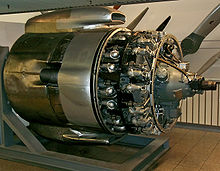Turbo compound engine

The turbo-compound engine is an internal combustion engine in which part of the energy content of the exhaust gases is used by a downstream utility turbine . It can be connected behind a turbocharger , but there were also compound engines with mechanical supercharging.
Working principle
When the exhaust valves open, the exhaust gases have a higher pressure than the ambient air; in an engine without an exhaust gas turbine, this pressure escapes largely unused. In a turbo engine, part of this pressure gradient is used to drive a turbo charger, which uses this energy to compress the air in the engine's intake tract. In a turbo-compound engine, the exhaust gas is expanded via a further turbine and the recovered energy is transferred to the crankshaft via a mechanical or hydraulic gear with a reduction of around 20: 1 to 30: 1 . This increases the efficiency and performance of the engine.
advantages
A consumption advantage can only be achieved if the exhaust gas turbocharger can provide enough air for combustion despite the power turbine, which reduces the pressure gradient for the turbocharger turbine, and the gas exchange losses are not too high. Up to now, it has not been used on a larger scale, since a consumption advantage over conventional turbocharger engines can only be achieved in small areas of the engine map and the turbo-compound technology is relatively complex. Turbo compound systems can be used most effectively in machines that work consistently over a long period of time in high load ranges. Use as a ship drive (e.g. Zvezda M520 ), as an aircraft engine or in road trains is therefore more sensible than with a truck in regional transport, which with a main power of around 100 kW (136 PS) works for large parts of its operating time in partial load ranges. The ability of a stationary compound machine to reduce consumption compared to a pure turbocharger engine is around five to seven percent under the most favorable conditions.
application
An example of a turbo compound engine is the Curtiss-Wright R-3350 , which was equipped with exhaust gas turbines for the Lockheed Super Constellation and Douglas DC-7 airliners from 1950 . It does not have a turbocharger - the engine is charged by a radial compressor driven by the crankshaft via a two-speed gearbox - but only three exhaust gas turbines that act on the crankshaft via hydraulic clutches and gear drives with a reduction ratio of 6.52: 1. With it, the conventional piston aircraft engine entered its final stage of development.
Napier & Son tested the combination of a two-stroke diesel engine with a turbo engine in the Napier Nomad . To a certain extent, the diesel worked as a combustion chamber of the mechanically coupled turbine system.
For large ship propulsion systems, MAN has developed a power turbine that generates up to 4700 kW of additional power. Here, the turbine drives a generator via a gearbox , which delivers the generated electrical energy either to the on-board network or to an electric motor coupled to the propeller shaft. This means that the drive system can achieve up to ten percent more power.
Mercedes , Scania and Volvo use turbo-compound technology in trucks.
In motor sports is of Porsche in Le Mans - prototypes 919 hybrid , in which a compound system used generates the electric with a second power turbine downstream of the exhaust gas turbocharger energy hybrid is fed system. In contrast to the other Le Mans prototypes from Audi , Nissan and Toyota , which (as of 2015) only recuperate with an MGU-K when braking , the Porsche 919 can thus also generate electrical energy when accelerating.
future
With hybrid-electric drives, the downsizing of the internal combustion engine increases the average power, which could also result in an interesting application of the turbo-compound engine, for example in city buses or delivery vehicles.
Alternatives
In addition to the mechanical decoupling by the turbo-compound turbine, it is also possible to convert the thermal energy from the exhaust gas directly into electricity.
literature
- Gert Hack, Iris Langkabel: Turbo and compressor motors . Motorbuch, Stuttgart 1999, ISBN 3-613-01950-7 .
- Richard van Basshuysen, Fred Schäfer: Handbook Internal Combustion Engine Basics, Components, Systems, Perspectives. 3rd edition, Friedrich Vieweg & Sohn Verlag / GWV Fachverlage, Wiesbaden 2005, ISBN 3-528-23933-6 .
Web links
Individual evidence
- ↑ Curtiss-Wright Co. (1956): Facts about the Wright Turbo-Compound ( Memento of the original from February 16, 2010 in the Internet Archive ) Info: The archive link was inserted automatically and has not yet been checked. Please check the original and archive link according to the instructions and then remove this notice. , PDF in English, accessed January 31, 2015.
- ↑ auto motor und sport: Porsche 919 Hybrid LMP1 - Porsche victories thanks to hybrid hammer?
- ↑ BMW: Electric power from thermal energy in the exhaust gases. NZZ , May 20, 2008, accessed on December 3, 2011 .

